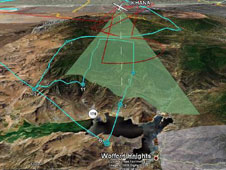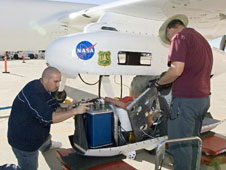 This 3-D illustration shows the real-time, mid-mission flight track of NASA’s Ikhana remotely piloted aircraft over Southern California’s Lake Isabella on Nov. 19, 2009. (NASA Image)MOFFETT FIELD, Calif. – NASA’s Ames Research Center, Moffett Field, Calif., has entered into a five-year Non-Reimbursable Space Act Agreement with the California Department of Forestry and Fire Protection (CAL FIRE) to use NASA technology and capabilities to help support the management and mitigation of wildfire disasters.
This 3-D illustration shows the real-time, mid-mission flight track of NASA’s Ikhana remotely piloted aircraft over Southern California’s Lake Isabella on Nov. 19, 2009. (NASA Image)MOFFETT FIELD, Calif. – NASA’s Ames Research Center, Moffett Field, Calif., has entered into a five-year Non-Reimbursable Space Act Agreement with the California Department of Forestry and Fire Protection (CAL FIRE) to use NASA technology and capabilities to help support the management and mitigation of wildfire disasters.
“The two entities have had an ad-hoc partnership for the last 25 years and this agreement formalizes our working relationship and allows the two agencies to explore new and exciting technology developments and capabilities that support the needs of the people of California,” said Vince Ambrosia, NASA Ames’ principal investigator and senior scientist of the collaborative effort.
“CAL FIRE is proud to formalize its partnership with NASA,” said Chief Ken Pimlott, director of CAL FIRE. “Under this agreement we will cooperatively explore the use and future transfer of advanced fire sensing technology. This in turn, will benefit the public we serve by helping CAL FIRE increase situational awareness and response efficiency.”
NASA has developed an innovative visible, infrared and thermal sensor called the NASA Autonomous Modular Scanner (AMS) at the Ames Research Center. The scanner has operated on both NASA’s Predator B Unmanned Aerial Vehicle (UAV) named Ikhana and a manned B-200 King Air operated by NASA’s Dryden Flight Research Center at Edwards, Calif. The scanner provides real-time wildfire imaging data over large-scale disaster events in the western United States and particularly in California. The innovations include performing all processing autonomously aboard the aircraft, and relaying the information through a satellite communications system to disaster managers located anywhere in the world.
 NASA Dryden’s Ikhana ground crewmen Gus Carreno and James Smith load the thermal-infrared imaging scanner pallet into the Ikhana’s underwing payload pod. (NASA Photo / Tom Tschida) The system performed flawlessly during several major wildfire events in southern California in 2007 and during the lightning fires in Northern California in 2008. Those missions were flown aboard the NASA Ikhana UAV. More recently, the team has focused on integration and operation of the sensor aboard the manned B-200 King Air aircraft.
NASA Dryden’s Ikhana ground crewmen Gus Carreno and James Smith load the thermal-infrared imaging scanner pallet into the Ikhana’s underwing payload pod. (NASA Photo / Tom Tschida) The system performed flawlessly during several major wildfire events in southern California in 2007 and during the lightning fires in Northern California in 2008. Those missions were flown aboard the NASA Ikhana UAV. More recently, the team has focused on integration and operation of the sensor aboard the manned B-200 King Air aircraft.
“The B-200 has more rapid response capability than the unmanned aerial vehicles. The exciting element is that we have the ability to use different platforms as the mission requirements change,” Ambrosia said.
For more on the Autonomous Modular Scanner and the Western States Fire Missions, visit:
https://www.nasa.gov/centers/dryden/research/wsfm.html
For more information about NASA Ames Research Center, visit:
https://www.nasa.gov/ames
For more about NASA Dryden Flight Research Center, visit:
https://www.nasa.gov/centers/dryden
– end –
text-only version of this release
To receive status reports and news releases issued from the Dryden Newsroom electronically, send a blank e-mail message to dfrc-subscribe@newsletters.nasa.gov. To unsubscribe, send a blank e-mail message to dfrc-unsubscribe@newsletters.nasa.gov. The system will confirm your request via e-mail.
Beth Hagenauer
Dryden Flight Research Center, Edwards, Calif.
661-276-7960
beth.hagenauer@nasa.gov
Karen Jenvey
Ames Research Center, Moffett Field, Calif.
650-604-4034
karen.jenvey@nasa.gov
Daniel Berlant
CAL FIRE, Sacramento, Calif.
916-651-3473
daniel.berlant@fire.ca.gov

























